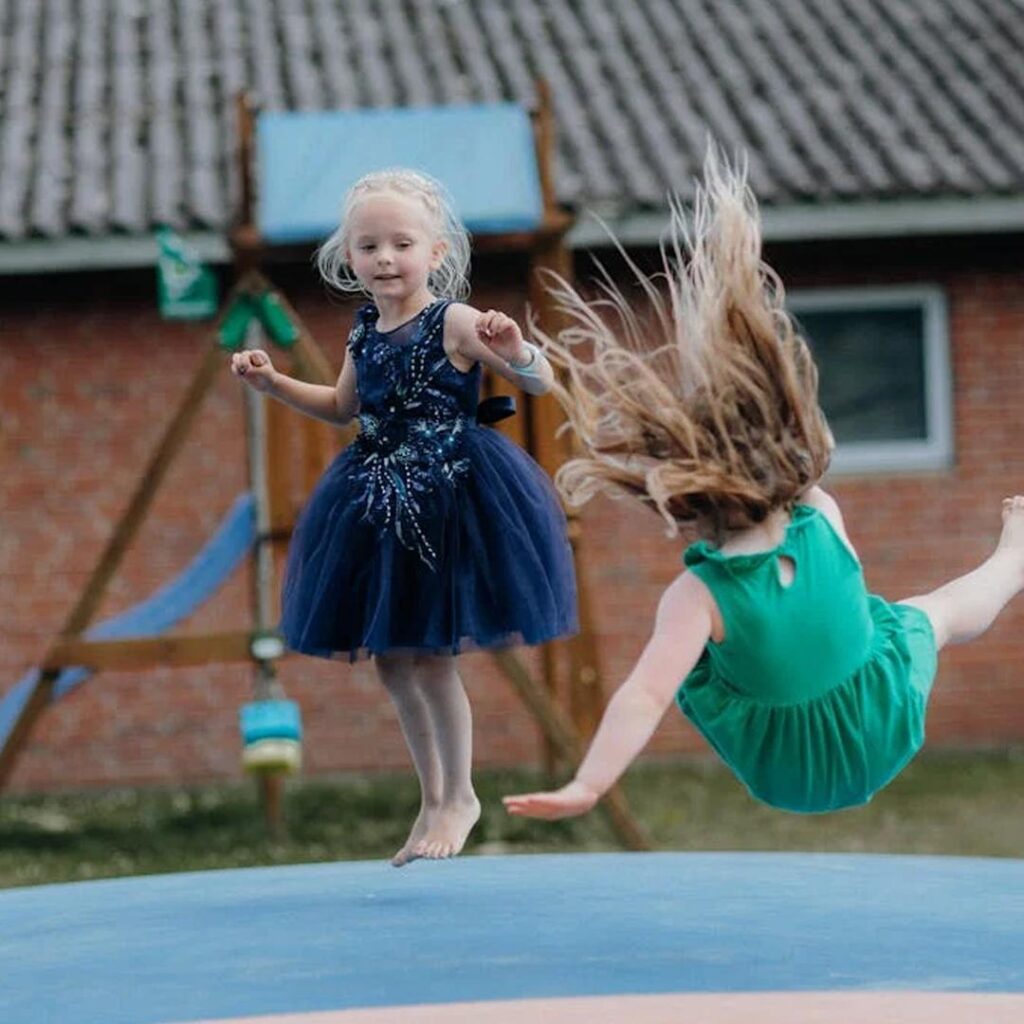Is play just for fun, or is there more to it? We often think of play as a break from serious learning, but what if play is the gateway to deeper development? Play-based learning is more than just fun and games; it’s a powerful tool that actively engages children in acquiring essential skills and knowledge. Imagine learning that feels less like a chore and more like an adventure.
As the focus on creative and immersive education grows, play-based learning is gaining recognition in schools and homes alike. This approach uses play as a natural vehicle for growth, stimulating curiosity, problem-solving, and social interaction. But here’s where it gets even more interesting—trampolines are becoming a key element in this learning style. Far from being just a garden toy, trampolines can transform learning into an exciting, hands-on experience for both children and adults.

In this blog, we’ll explore how trampolines support play-based learning, making education more engaging, effective, and fun for all ages. Ready to jump into it?
What Research Says
Can play shape the way we learn? Research certainly thinks so. Studies have consistently shown that play-based learning isn’t just a fun pastime; it’s a critical element in the cognitive, social, and emotional development of children. When children engage in play, they’re not just entertaining themselves—they’re building problem-solving skills, improving communication, and learning how to navigate social interactions. But it doesn’t stop there; play taps into emotional growth too, helping children manage their feelings and develop empathy.
British psychologist Susan Isaacs once noted that play is a child’s “work,” highlighting how the environment and the people involved are crucial in making learning through play effective. The playful setting becomes a rich ground for developing creativity, curiosity, and independence. Lev Vygotsky’s theory adds to this by suggesting that social play pushes children beyond their current abilities, fostering growth in what he called the “zone of proximal development.” In simple terms, children stretch their skills when supported by knowledgeable adults or peers.
How do trampolines fit into this? Family Trampolines have been used in various studies to show how movement enhances learning. Bouncing stimulates both the body and mind, improving balance, coordination, and spatial awareness. It also makes learning physical concepts, like motion and gravity, feel real and engaging.
Quick Takeaways
- Cognitive benefits: Problem-solving and critical thinking improve during play.
- Social growth: Children learn cooperation, sharing, and empathy.
- Emotional development: Play helps in managing emotions and reducing stress.
- Trampolines add value: Physical play through trampolining boosts learning by making abstract concepts tangible.
As research clearly shows, play-based learning is a powerhouse for development, engaging the mind, body, and emotions in ways that traditional methods often overlook. But how exactly does this play-driven approach translate into real-life benefits for both children and adults? Let’s dive deeper into the specific advantages of play-based learning and explore how trampolines take these benefits to new heights.
Benefits of Play-Based Learning
What if play is the secret ingredient to lifelong learning? It turns out, play-based learning offers a treasure trove of benefits that extend far beyond mere fun. From strengthening physical skills to fostering creativity, engaging in play is pivotal in shaping well-rounded individuals. Here’s a closer look at the educational advantages of play that can transform how we view learning:
Strengthen Development
Play-based learning is a dynamic way to enhance both physical and cognitive abilities. When children engage in active play, whether it’s bouncing on a sport trampoline or climbing a jungle gym, they develop gross motor skills, coordination, and balance. Simultaneously, they challenge their minds, solving problems and navigating new situations.
Develop Social and Cultural Identities and Relationships
Play serves as a bridge for children to connect with their peers. Through cooperative games and shared activities, they learn to build friendships, understand social norms, and appreciate diverse cultural backgrounds. This social interaction lays the groundwork for their identities, helping them develop empathy and respect for others.
Encourage Positive Behaviour
Who knew that play could instil values? Engaging in team-based activities encourages children to embrace teamwork, develop respect for others, and foster a love for learning. When children play, they learn that cooperation leads to success, nurturing positive behaviours that last a lifetime.
Encourage Self-Expression and Creativity
Open-ended play allows children to tap into their imagination and express themselves freely. Whether they’re inventing stories or building fantastical worlds, play encourages creativity, critical thinking, and problem-solving—skills vital for their future.
Learning Risk-Taking
Play provides a safe space for children to explore healthy risks. Whether it’s trying a daring jump on an in-ground trampoline or experimenting with new ideas during creative play, children develop resilience and decision-making skills that empower them to face challenges head-on.
In essence, play-based learning is a powerful engine driving comprehensive development. By understanding these benefits, we can appreciate why integrating trampolines into this learning approach can elevate both play and education to exhilarating new heights. Ready to see how trampolines can transform the learning experience? Let’s explore their unique role in enhancing play-based learning next!
Why Trampolines Are Perfect for Play-Based Learning
Could trampolines be the ultimate learning tool for all ages? The answer is a resounding yes! Garden Trampolines are not just for fun; they’re an extraordinary resource that enhances play-based learning for both children and adults. Let’s dive into the myriad ways trampolines support this engaging and dynamic approach to education.
For Children: Boosting Child Development and Fun
- Learning without Limits: Trampolines are fantastic for teaching children essential skills without sacrificing enjoyment. As they bounce, children naturally develop coordination, balance, and motor skills—building blocks for future physical activities.
- Feeling Alive: The sheer thrill of bouncing provides an exhilarating experience that skyrockets engagement and energy levels. When children feel invigorated, they’re more likely to embrace learning opportunities that come their way.
- Openness to Learning: Physical play on trampolines can lead to a readiness for academic lessons. When children experience joy through movement, they’re more receptive to new ideas, turning learning into an exciting adventure rather than a chore.
- Confidence Boost: Mastering new trampoline tricks helps children gain self-assurance. Each successful jump builds their confidence, encouraging them to tackle challenges both on and off the trampoline.
- Fun with Math and Science: Counting jumps or measuring heights introduces foundational concepts in maths and physics. As children engage in playful calculations, they learn to associate academic subjects with enjoyable experiences.
For Adults: Not Just for Children—Adults Benefit Too!
- Sharpening Focus: Trampoline exercise isn’t just child’s play; it enhances concentration and mental clarity for adults as well. The rhythm of bouncing allows for improved cognitive function, making it easier to tackle everyday tasks.
- Making Learning Fun: Adults can integrate trampolines into hands-on experiments, adding an exciting twist to conventional lessons. Whether it’s in a workshop or a fitness class, learning becomes a lively experience rather than a dull lecture.
- Stress Relief: Trampolining is a fantastic stress-buster. The laughter and joy that come from bouncing can melt away the day’s worries, providing a refreshing escape from life’s pressures.
- A Fun Health Alternative: Why settle for mundane workouts? Trampolining combines fitness and physical skills with fun, making it an enjoyable way to maintain a healthier lifestyle.
- Great Exercise Tool: From improved cardiovascular health to muscle toning and enhanced flexibility, trampolines offer a myriad of physical benefits. Adults can stay fit while having a blast!
- Role Models in Action: When adults participate in play-based learning activities, they set a positive example for younger generations. This shared experience fosters stronger connections and encourages a lifelong love for learning.
With their unique ability to foster physical, cognitive, and emotional growth, trampolines elevate play-based learning to new heights. So, what accessories can enhance this experience even further? Let’s explore some exciting additions that make learning even more fun!
Accessories That Can Make Learning Fun
- Ready to amplify the fun in learning? The right accessories can turn a standard trampoline experience into an extraordinary educational adventure. Let’s explore some innovative trampoline accessories that elevate play-based learning, making it not just enjoyable but also effective.
- Trampoline Scooter: Imagine gliding across the trampoline on a scooter while mastering balance and coordination! The trampoline scooter adds an exhilarating twist to play, allowing children to navigate their bouncing space creatively. This accessory fosters essential motor skills while ensuring that learning remains a thrilling experience.
- Basketball Hoops: Want to add a competitive edge to your trampoline fun? Incorporating basketball hoops encourages children to practise aiming and hand-eye coordination. As they bounce to shoot hoops, they’re not just having a blast—they’re also developing critical skills that extend beyond the trampoline.
- Swing Bags: The addition of swing bags promotes playful physical movement while encouraging strength and agility. Children can leap into the air, swinging through the air as they build core strength and coordination. This dynamic accessory turns exercise into a joyful experience, merging fun with fitness seamlessly.
- Trampoline with Sliders: Why settle for just bouncing when you can slide too? Trampolines equipped with sliders add an element of creative play that sparks the imagination. Children can experiment with different movements and controls, enhancing their understanding of spatial awareness and balance.
With these accessories, trampolining transforms into a vibrant learning environment where fun meets education. Ready to take your play-based learning to new heights?
Conclusion
Trampolines are not just sources of fun; they are powerful tools for play-based learning that benefit both children and adults. By enhancing physical and cognitive development, fostering social connections, and providing a unique way to engage with educational concepts, trampolines transform learning into an exhilarating experience.
Ready to elevate learning? Explore a range of trampoline products and accessories that can enhance play-based learning at home or in schools. Let’s keep the child inside you alive with Super Tramp Trampolines!
We’d love to hear from you! Share your trampoline experiences and stories in the comments, or feel free to drop any questions you may have. As we look to the future, remember: that play-based learning is the key to unlocking endless possibilities for growth and creativity.
Trampolines enhance balance, coordination, spatial awareness, and cognitive skills, making learning active and enjoyable.
They boost physical strength, motor skills, confidence, and social interaction, contributing to holistic growth.
By encouraging jumping, bouncing, and balancing, trampolines develop core stability, coordination, and large muscle group control.
Play-based learning nurtures creativity, critical thinking, and social skills while making education engaging and enjoyable.
Key skills include balance, coordination, timing, agility, and spatial awareness.





